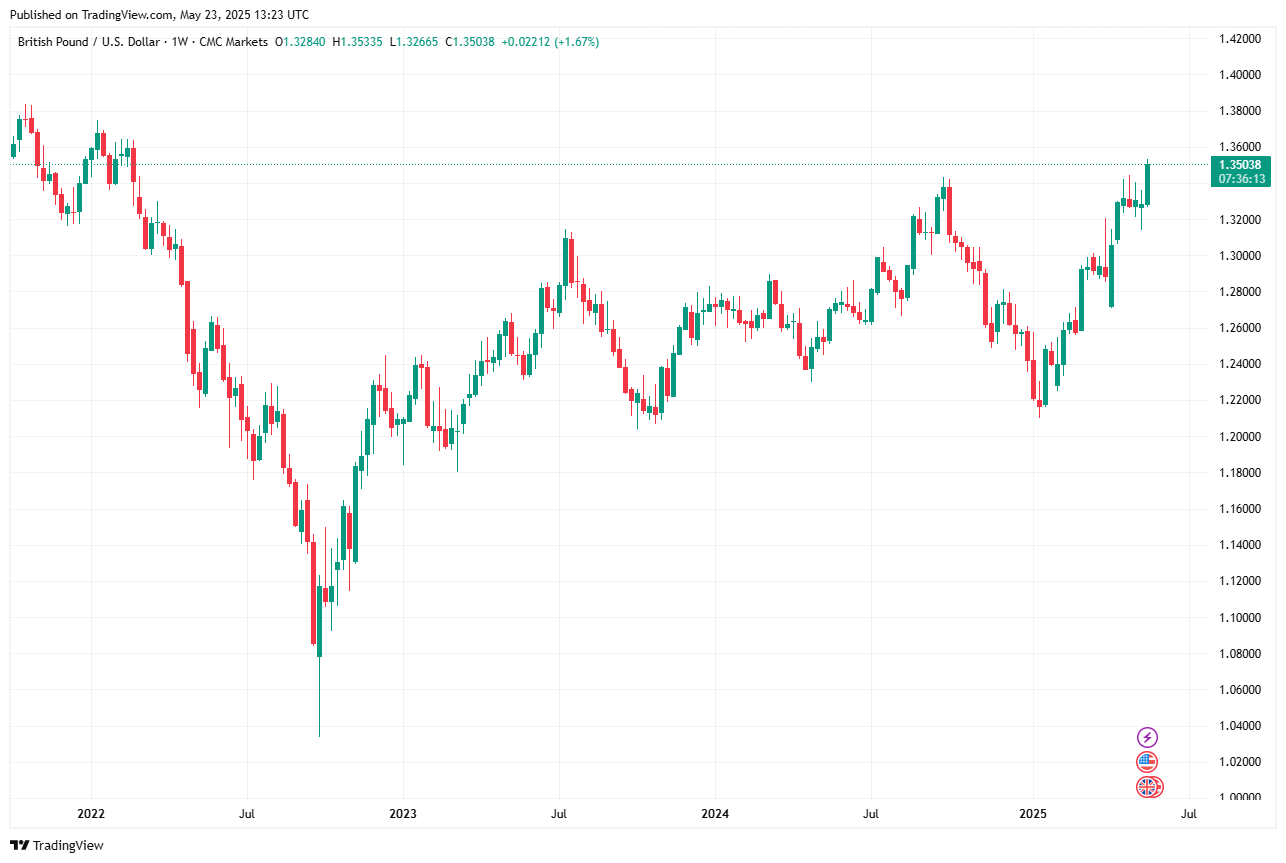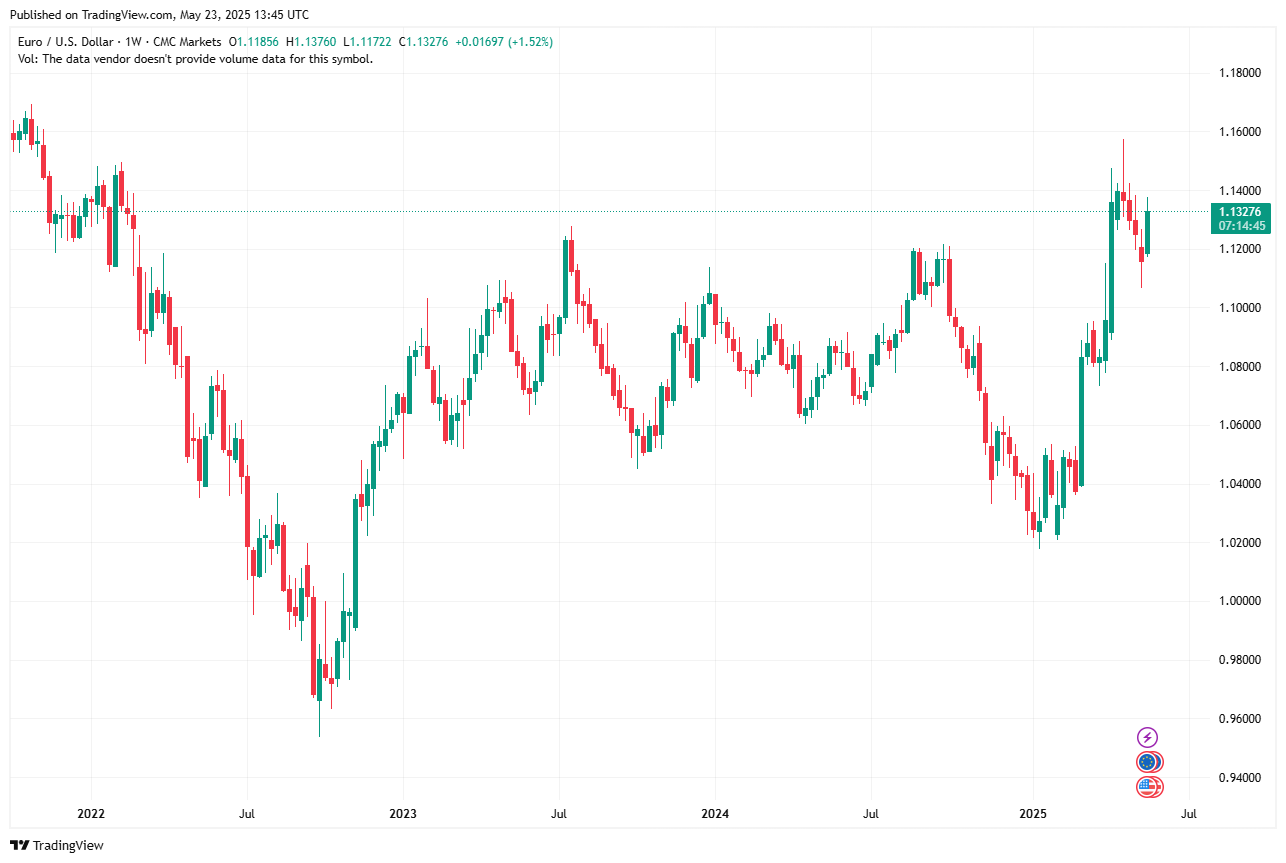UK Retail Sales Surge Highlights Consumer Resilience
Sterling has broken through a three-year high against the US dollar, on track for its strongest weekly performance in six, buoyed by a softer dollar and a raft of upbeat UK data. Retail sales, released this morning, exceeded expectations—another indication that British consumers remain resilient despite higher living costs and ongoing global trade tensions.

UK retail sales rose by 1.2% in April, marking the fourth consecutive monthly gain and capping the strongest quarter for the retail sector since 2021. The improvement has been driven by warmer weather and a modest uptick in consumer sentiment. Indeed, GfK’s latest figures show consumer confidence edged up in May, with its index rising three points to -20.
Elsewhere, UK public sector borrowing reached £20.2 billion, surpassing forecasts, although earlier months were revised down. At the same time, 30-year gilt yields breached 5.50%, reflecting broader turbulence in global bond markets, notably in the US and Japan. The rise in yields presents a growing challenge for Chancellor Rachel Reeves, with average borrowing costs since the Autumn Statement now at 5.15%—55 basis points higher than in the previous six months. Should volatility in bond markets persist, Reeves could come under increasing pressure, particularly if fiscal data continues to disappoint.
Nonetheless, several factors continue to support sterling: improving trade ties with the US and EU, a run of positive economic surprises, stubbornly high inflation that is keeping the Bank of England on a less dovish path, and a broader de-dollarisation trend. The options market reflects growing optimism over sterling’s longer-term prospects, with hedge funds steadily increasing their long positions since January. Rising demand from institutional investors suggests further upside potential—especially if asset managers begin to overweight the pound in the months ahead.
That said, sterling’s gains against the euro remain constrained, with EUR/GBP hovering around the €1.19 mark and still down over 1.5% year-to-date. However, with the UK economy showing resilience and avoiding recession, and with the BoE maintaining a comparatively hawkish stance, sterling remains well-supported. Its renewed role in diversification strategies and the ongoing G10 de-dollarisation theme continue to underpin bullish sentiment toward the pound.
Focus Shifts to Fiscal Policy
This week, two major developments drew market attention: a disappointing US bond auction and the House Republicans' approval of what they have dubbed the “Big, Beautiful Tax Bill.”
First, the US Treasury conducted a routine auction of $16 billion in new 20-year bonds. Normally unremarkable, this auction unsettled investors amid concerns about the mounting uncertainty in US economic policy—particularly the market's ability to absorb the refinancing of nearly $3 trillion in debt maturing in 2025, much of it short-dated. Their apprehension may be warranted: the auction produced a yield of 5.05% on the 20-year note, a notable rise from the 4.6% average of the previous five auctions. While 20-year bonds are generally less liquid than other maturities, the subdued demand triggered alarm across financial markets. But does this signal deeper trouble for the world’s largest debt market?
To contextualise, a significant share of the US government’s maturing debt is short-term. Since 2000, securities with less than one year to maturity have consistently accounted for 25% to 40% of the total. When combined with 1- to 5-year notes, short- and medium-term debt represents approximately 70% of the total structure.
Compounding matters, the weak auction coincides with rising investor anxiety over a Republican-led Congress advancing a tax package that could add an estimated $3.3 trillion to the national debt by 2034. Historically, the US federal deficit has averaged 3.4% of nominal GDP. However, widening deficits in a high-interest-rate environment prompt legitimate concerns about long-term fiscal sustainability.
Despite this, the newly passed tax bill, which is expected to contribute around $380 billion annually to the deficit, includes a baseline 10% tariff that could partially offset the fiscal gap. Tariffs have become a durable fixture of US trade policy, and their associated revenues are increasingly integral to the country’s fiscal outlook. According to the Congressional Budget Office (CBO), current tariff regimes are projected to generate approximately $2.7 trillion between 2026 and 2035. Even allowing for potential economic headwinds, tariff income could still reach around $2.3 trillion over that period.
As fiscal policy becomes clearer, the uncertainty premium embedded in long-term yields may begin to diminish, potentially calming markets. Indeed, the US dollar index regained some momentum ahead of the weekend, rebounding from a weekly low of 99.3. Still, the dollar is set for its largest weekly drop in six and continues to struggle to reclaim the key 100 threshold.
Euro Shrugs Off Weak PMI Figures
EUR/USD largely shrugged off an intraday decline of nearly 0.4% following a series of underwhelming PMI releases across key Eurozone economies, including France, Germany, and the broader bloc. The Eurozone Composite PMI slipped from 50.4 to 49.5 in May, driven primarily by a downturn in the services sector. While manufacturing has remained sluggish, the once-resilient services industry has now also entered contractionary territory.

Adding to the bearish mood were minutes from the ECB’s April meeting, which highlighted policymakers’ growing concerns over the region’s subdued economic outlook. The tone indicated that a dovish policy stance is likely to persist, especially against a backdrop of easing inflation. Taken together, these developments reinforce the narrative of a faltering Eurozone economy weighed down by uncertainty. Nevertheless, EUR/USD clawed back some losses by the day’s end, reflecting ongoing market belief that the euro retains a relative advantage over the dollar for now.
Supporting the euro’s rebound may have been the European Union’s proactive move to de-escalate trade tensions with the US, as it submitted a revised trade proposal to the White House. While we maintain a constructive outlook on EUR/USD—still trading above both short- and long-term moving averages—any sustained recovery will likely depend on stronger hard data and greater clarity on trade relations.










